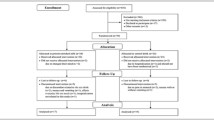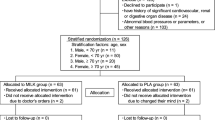Abstract
Objectives
Leucine-rich milk and whey proteins have been suggested for prevention of age related loss of muscle mass and strength i.e. sarcopenia. The effects of milk protein supplementation and low intensity home based physical exercise on body composition and muscle functions were investigated.
Design
A randomized double blind crossover trial.
Setting
Community dwelling members of Helsinki rheumatoid association.
Participants
Older people (N = 47, mean age 69.5 years) suffering from polymyalgia rheumatica.
Intervention
Patients performed as many stand ups as possible twice a day after which they ingested a regular (Control) or a whey protein enriched dairy product with high leucine content (Test). The 8-week intervention periods were separated by a 4-week wash-out.
Measurements
Body composition was measured by dual x-ray absorptiometry and muscle functions by hand grip strength, force platform countermovement jump performance, chair stand test, and walking speed.
Results
The 16-week home-based post-exercise supplementation resulted in a 1.8% increase (p = 0.052) in lower limb muscle mass. Walking speed (+5.3%, p = 0.007) and chair stand test performance (−12.2 %, p < 0.001) were also improved. Furthermore, a tendency for increased jump power (+3.0%, p = 0.084) was observed. However, significant and consistent differences were not found in the changes of muscle mass indices or muscle functions between supplements, but the test supplement tended to prevent accumulation of body fat.
Conclusion
A low intensity home based exercise program combined with post-exercise milk protein supplementation is feasible despite some gastrointestinal complaints and seems effective in improving the muscle mass and functions of older persons with a inflammatory disease. Further studies are needed to establish, whether and to what extent the use of leucine-enriched whey products prevent or treat age-associated sarcopenia and whether they are superior to the present commercial milk products.
Similar content being viewed by others
References
Morley JE. Sarcopenia: diagnosis and treatment. J Nutr Health Aging. 2008;12:452–456.
Roubenoff R. Physical activity, inflammation, and muscle loss. Nutr Rev. 2007;65:S208–S212.
Frankel JE, Bean JF, Frontera WR. Exercise in the elderly: research and clinical practice. Clin Geriatr Med. 2006;22:239–256.
Singh MA. Exercise to prevent and treat functional disability. Clin Geriatr Med. 2002;18:431–462.
Heath JM, Stuart MR. Prescribing exercise for frail elders. J Am Board Fam Pract. 2002;15:218–228.
van Kan GA, Rolland YM, Morley JE, et al. Frailty: toward a clinical definition. J Am Med Dir Assoc. 2008;9:71–72.
Paddon-Jones D, Rasmussen BB. Dietary protein recommendations and the prevention of sarcopenia. Curr Opin Clin Nutr Metab Care. 2009;12:86–90.
Campbell WW. Synergistic use of higher-protein diets or nutritional supplements with resistance training to counter sarcopenia. Nutr Rev. 2007;65:416–422.
Fiatarone MA, O’Neill EF, Ryan ND, et al. Exercise training and nutritional supplementation for physical frailty in very elderly people. N Engl J Med. 1994;330:1769–1775.
Dillon EL, Sheffield-Moore M, Paddon-Jones D, et al. Amino acid supplementation increases lean body mass, basal muscle protein synthesis, and insulin-like growth factor-I expression in older women. J Clin Endocrinol Metab. 2009;94:1630–1637.
Solerte SB, Gazzaruso C, Bonacasa R, et al. Nutritional supplements with oral amino acid mixtures increases whole-body lean mass and insulin sensitivity in elderly subjects with sarcopenia. Am J Cardiol. 2008;101:69E–77E.
Scognamiglio R, Piccolotto R, Negut C, et al. Oral amino acids in elderly subjects: effect on myocardial function and walking capacity. Gerontology. 2005;51:302–308.
Drummond MJ, Dreyer HC, Fry CS, et al. Nutritional and contractile regulation of human skeletal muscle protein synthesis and mTORC1 signaling. J Appl Physiol. 2009;106:1374–1384.
Tang JE, Phillips SM. Maximizing muscle protein anabolism: the role of protein quality. Curr Opin Clin Nutr Metab Care. 2009;12:66–71.
Katsanos CS, Chinkes DL, Paddon-Jones D, et al. Whey protein ingestion in elderly persons results in greater muscle protein accrual than ingestion of its constituent essential amino acid content. Nutr Res. 2008;28:651–658.
Baumgartner RN, Koehler KM, Gallagher D, et al. Epidemiology of sarcopenia among the elderly in New Mexico. Am J Epidemiol. 1998;147:755–763.
Melton LJ, Khosla S, Crowson CS,et al. Epidemiology of sarcopenia. J Am Geriatr Soc. 2000;48:625–630.
Janssen I, Heymsfield SB, Ross R. Low relative skeletal muscle mass (Sarcopenia) in older persons is associated with functional impairment and physical disability. J Am Geriatr Soc. 2002;50:889–896.
Schutz Y, Kyle UUG, Pichard C. Fat-free mass index and fat mass index percentiles in Caucasians aged 18e98y. Int J Obes 2002;26:953–960.
Salvarani C, Cantini F, Hunder GG. Polymyalgia rheumatica and giant-cell arteritis. Lancet 2008;234–245.
Nothnagl T, Leeb BF. Diagnosis, differential diagnosis and treatment of polymyalgia rheumatica. Drugs Aging. 2006;23:391–402.
Hoes JN, Jacobs JW, Verstappen SM, et al. Adverse events of low-to-medium-dose oral glucocorticoids in inflammatory diseases: A meta-analysis. Ann Rheum Dis. 2009;68:1833–1838.
Rubenstein LZ, Harker JO, Salva A, et al. Screening for Undernutrition in Geriatric Practice: Developing the Short-Fom Mini Nutritional Assessment (MNA-SF). J. Geront 2001;56A: M366–M377.
Arkela-Kautiainen M, Kautiainen H, Uutela T, et al. Evaluation of the MDHAQ in Finnish patients with RA [corrected]. J Rheumatol. 2005;32:1426–1431.
Pincus T, Swearingen CJ, Bergman M, et al. RAPID3 (Routine Assessment of Patient Index Data 3), a rheumatoid arthritis index without formal joint counts for routine care: proposed severity categories compared to disease activity score and clinical disease activity index categories. J Rheumatol. 2008;35:2136–2147.
Rossier P, Wade DT. Validity and reliability comparison of 4 mobility measures in patients presenting with neurologic impairment. Arch Phys Med Rehabil. 2001;82:9–13.
Guralnik JM, Simonsick EM, Ferrucci L, et al. A short physical performance battery assessing lower extremity function: association with self-reported disability and prediction of mortality and nursing home admission. J Gerontol. 1994;49:M85–M94.
Leeb BF, Bird HA. A disease activity score for polymyalgia rheumatica. Ann Rheum Dis. 2004;63:1279–1283.
Binard A, Lefebvre B, De Bandt M, et al. Validity of the polymyalgia rheumatica activity score in primary care practice. Ann Rheum Dis. 2009;68:541–545.
Koopman R, van Loon LJ. Aging, exercise, and muscle protein metabolism. J Appl Physiol. 2009;106:2040–2048.
Atherton PJ, Smith K, Etheridge T, et al. Distinct anabolic signalling responses to amino acids in C2C12 skeletal muscle cells. Amino Acids. 2009;[Epub ahead of print]
Koopman R, Verdijk LB, Beelen M, et al. Co-ingestion of leucine with protein does not further augment post-exercise muscle protein synthesis rates in elderly men. Br J Nutr. 2008;99:571–580.
Verhoeven S, Vanschoonbeek K, Verdijk LB, et al. Long-term leucine supplementation does not increase muscle mass or strength in healthy elderly men. Am J Clin Nutr. 2009;89:1468–1475.
Pilvi TK, Korpela R, Huttunen M, et al. High-calcium diet with whey protein attenuates body-weight gain in high-fat-fed C57Bl/6J mice. Br J Nutr. 2007;98:900–907.
Pilvi TK, Harala S, Korpela R, et al. Effects of high-calcium diets with different whey proteins on weight loss and weight regain in high-fat-fed C57BL/6J mice. Br J Nutr. 2009;102:337–341.
Gilani GS, Sepehr E. Protein digestibility and quality in products containing antinutritional factors are adversely affected by old age in rats. J Nutr. 2003;133:220–225.
Stenholm S, Harris TB, Rantanen T, et al. Sarcopenic obesity: definition, cause and consequences. Curr Opin Clin Nutr Metab Care. 2008;11:693–700.
Evans W. Skeletal muscle loss: cachexia, sarcopenia, and inactivity. Am J Clin Nutr. 2010;91:1123S–1127S.
Author information
Authors and Affiliations
Corresponding author
Rights and permissions
About this article
Cite this article
Björkman, M.P., Pilvi, T.K., Kekkonen, R.A. et al. Similar effects of leucine rich and regular dairy products on muscle mass and functions of older polymyalgia rheumatica patients: A randomized crossover trial. J Nutr Health Aging 15, 462–467 (2011). https://doi.org/10.1007/s12603-010-0276-6
Received:
Accepted:
Published:
Issue Date:
DOI: https://doi.org/10.1007/s12603-010-0276-6




